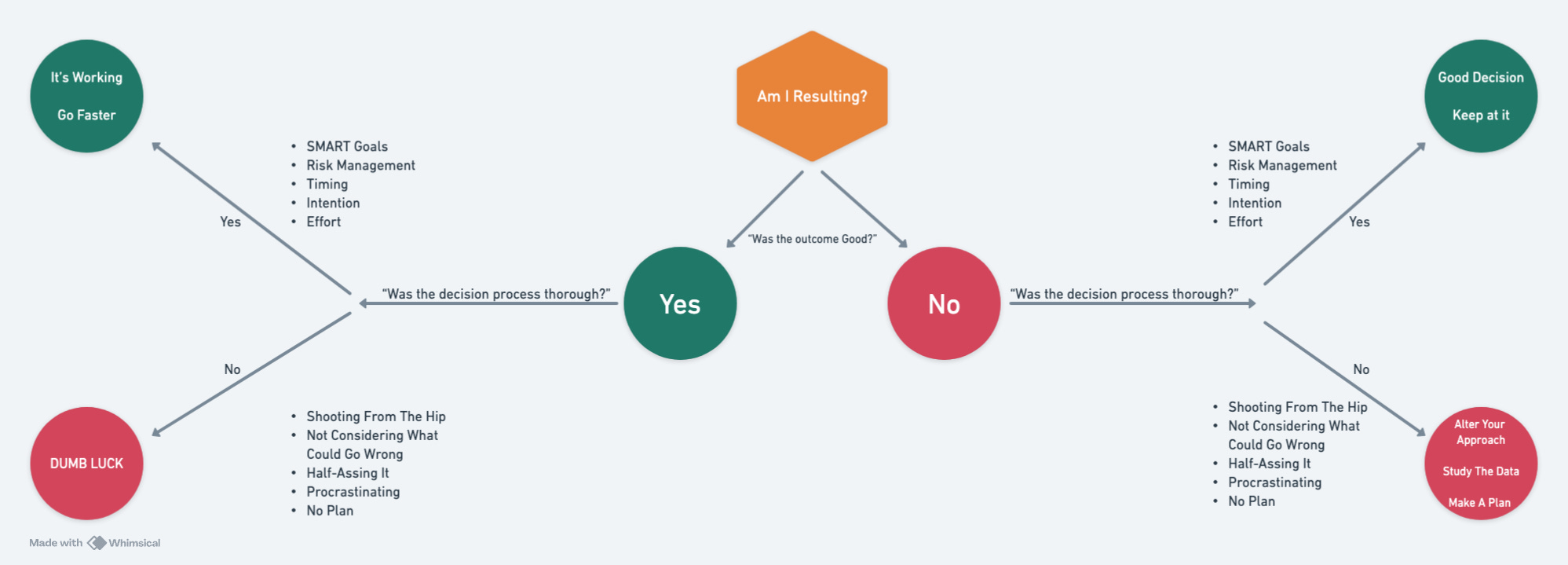Yo, it’s Drew. Welcome back to Grace Notes, the newsletter that helps you move through artist entrepreneurship gracefully.
You lost the client. Again.
You emailed them back and forth for weeks, answered every objection they threw your way…and still, they passed.
“Too expensive.”
You start wondering:
“Am I charging too much for my work?”
No, you’re not.
That voice inside your head, the one whispering that rejection is proof you’re failing, is lying to you.
This thought process is called “resulting.”
If left unchecked, resulting bias will make you question every decision you make. You will begin to fear the results of your decisions, and it will dump you into an eternal purgatory of analysis paralysis.
Let me explain you how your brain might be lying to you — and how to fight back.
What Is “Resulting”?
Coined by professional poker player Annie Duke in her book Thinking in Bets, “resulting” is a mental trap where we judge the quality of our decisions based on their outcomes.
In poker you have roll with the cards you are dealt. Because you cannot see the cards other people are holding, you have incomplete information.
Operating a freelance music career is similar. Sometimes you have 0 gigs on your calendar. You have no control over the calls that come your way. And sometimes you have to weigh one opportunity against another.
In both games, you have to make the best possible decision with limited information:
You could say yes to an incredible opportunity, and then get an EVEN BIGGER opportunity that conflicts with it. Was it wrong to say “yes” to the first opportunity?
You could hire a high-demand string player for a session with a huge artist, and they could cancel on you last-minute, leaving you with a terrible sub. Was it wrong to hire this person?
You could record for a major label artist’s album and not get called to tour that album across the tour. Was it wrong to say yes to the recording gig?
The point is, you can make good decisions still get bad outcomes. Your only goal is to separate the quality of your decision from the outcome. T
his is how you avoid resulting bias.
To start, you HAVE to start viewing the world through the lens of probabilities.
This is what we assume:
Good Outcomes = Smart Decisions
Bad Outcomes = Dumb Decisions
This is a dangerous shortcut.
In reality, every decision leads to a constellation of probable futures. Some of them are good, and some of them are bad.
Every good decision has a probability of creating a bad outcome. Every bad decision has a probability of creating a good outcome.
Certainty Is a Myth: Action = Power
It is impossible to know every variable. Come to peace with the unknown.
Too many creatives wait for “certainty” before launching that YouTube channel, cold emailing that venue, or asking for a higher rate.
But certainty is a stall tactic your fear uses to protect your ego.
Start thinking this way:
Failure is not your identity. It’s data.
An L is not a loss if it leads to better decisions next time.
The best freelancers aren’t always right. They’re just always learning.
For example:
Let us say you raise your solo luxury event fees from $1000/hr to $2000/hr. The outcome of this decision brought your closing rate from about 90% to 20%.
Most people would panic and lower their fees back. This would be resulting.
Resulting says: “The raise caused my closing rate to decline by 70%. This was a bad decision.”
But was it a bad decision? Maybe those clients weren’t your target market. Maybe you just started filtering in the right ones.
So, how can you separate the outcome from the quality of your decisions? How do you fight resulting bias?
Are You Resulting? (Flowchart)
Good decisions can still hurt. Let’s separate the signal from the noise:
You have to evaluate the results of your decisions. Otherwise, you will never know if the quality of your decision making is sound. Repeated bad decisions will stall your progress, so be sure to put in the work.
To evaluate the quality of your decisions, follow this flowchart.
Good decisions require:
SMART goals
Intentional, thorough plans with contingencies for foreseeable risks
Execution at the right time, in the right order
Focused effort
Bad decisions tend to:
Be put off until the very last minute, often after limited thought or deliberation
Ignore what could go wrong
Lack effort, planning, or focus
If things go wrong, look at what you did.
Your plans were solid, your execution was flawless, and you still failed? No sweat, dust yourself off, and try again.
Do not assign your self-worth to external results. Just remember that the one thing you can control is your effort.
Become a Researcher, Not a Judge
Don’t just try harder. Track smarter.
Think like a scientist:
Write down the decision before the outcome (journals > memory).
Note your reasons, assumptions, and risks.
Set a review date. (One week? One month?)
Ask: What did I learn? What would I repeat? What would I tweak?
Example: You start a TikTok series. After 10 posts, no traction. Was the idea bad? Maybe not.
Maybe:
Your posting time was suboptimal
Your hook was too soft.
You are not speaking to your target audience
You need to niche further and create more brand clarity
Don’t quit. Iterate. You can’t A/B test your way to growth without a little failure in the mix.
Final Warning: Good Outcomes Can Lie Too
Here’s the scary part: Resulting works both ways.
A bad decision with a good outcome? That’s just as dangerous. You might think you’re crushing it — but you’re reinforcing luck, not strategy.
Example: You procrastinate, skip practice, and still land a sub gig at a major orchestra. That one-off win might trick you into thinking your habits are fine. They’re not. If you repeat the pattern, you’re flying blind.
Takeaways
Failing at something does not make you a failure.
In fact, your willingness to fail might be the first win on the path to long-term success.
Good decisions sometimes lead to bad outcomes — and that’s okay. That’s normal. That’s the game.
You’re not here to look smart. You’re here to get smart.
Keep playing the long game. Make strong bets. Track your moves. Fail forward.
This is how you avoid resulting bias and eliminate your fear of failure.
Thanks for reading, ya’ll.
Talk to you next week,
Drew






I REALLY like this way of looking at things! Having this in my toolkit is going to help, I can tell. Thanks for sharing!